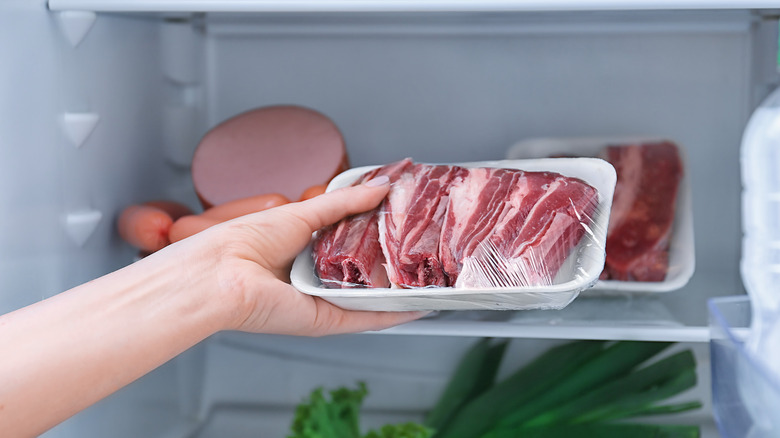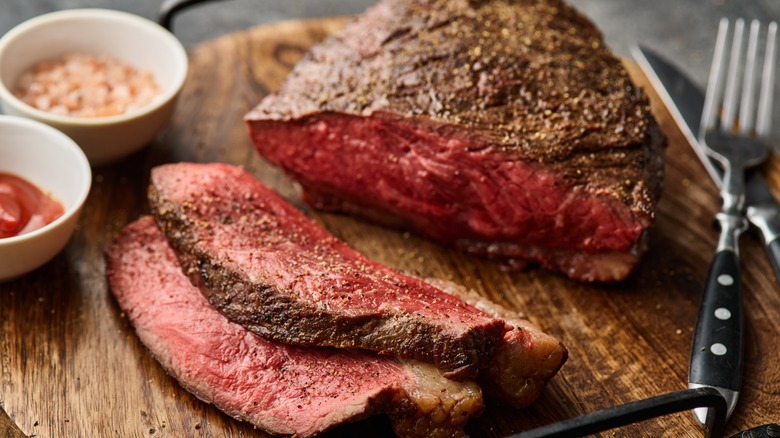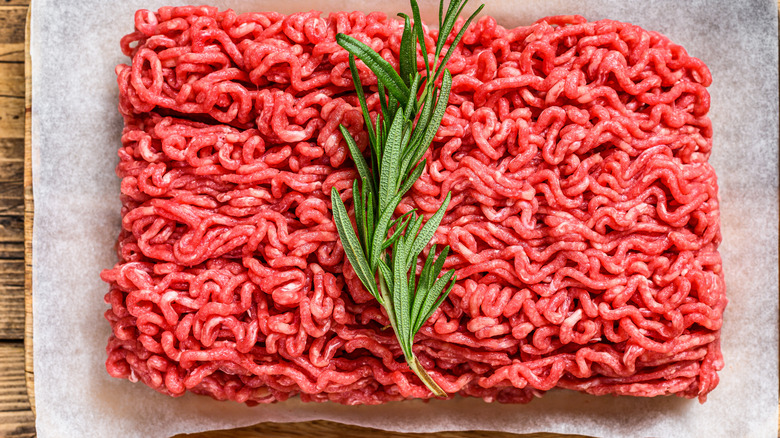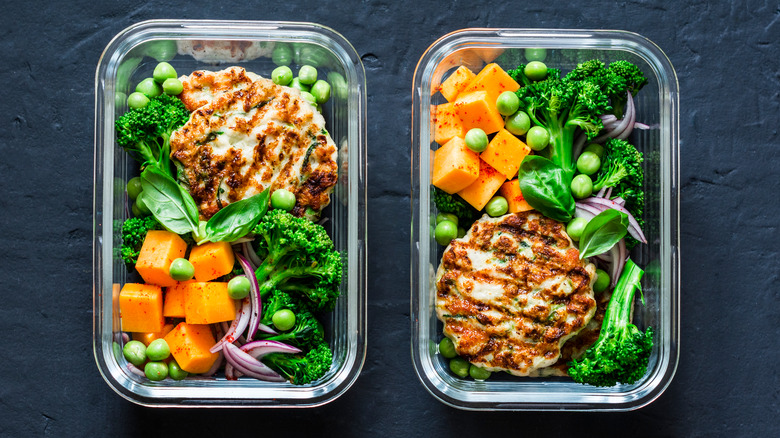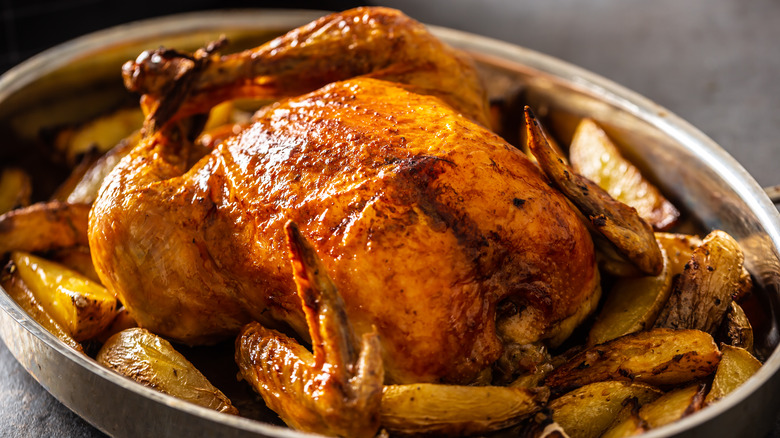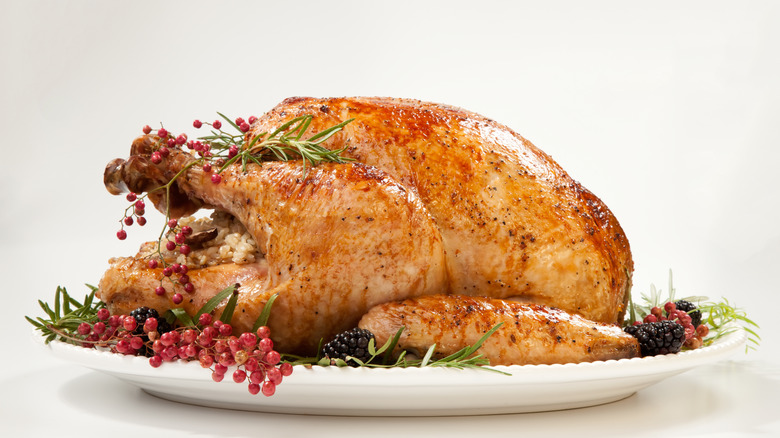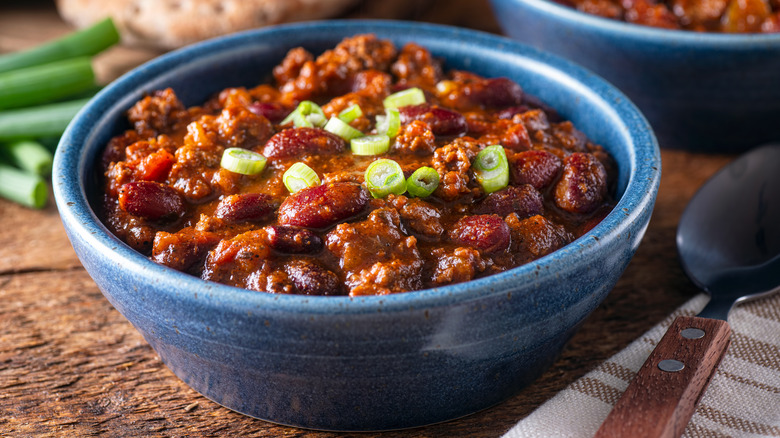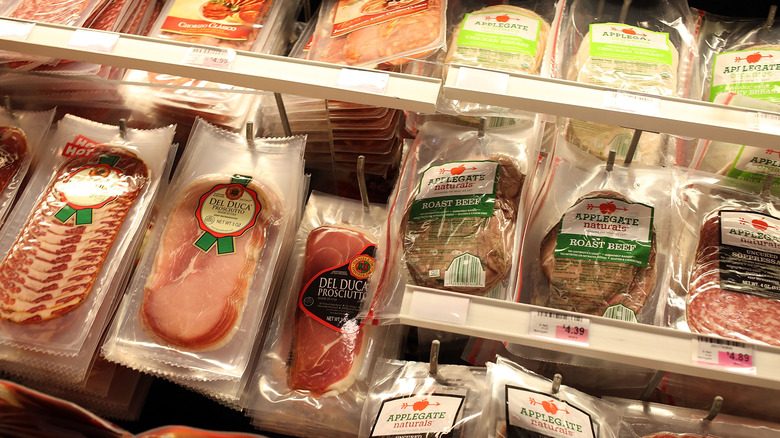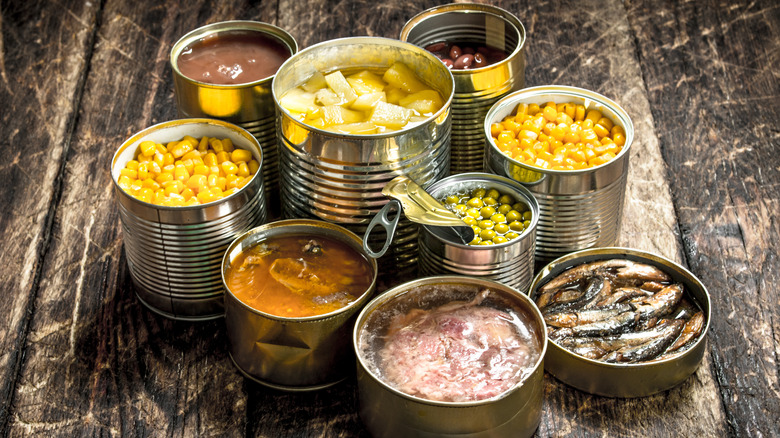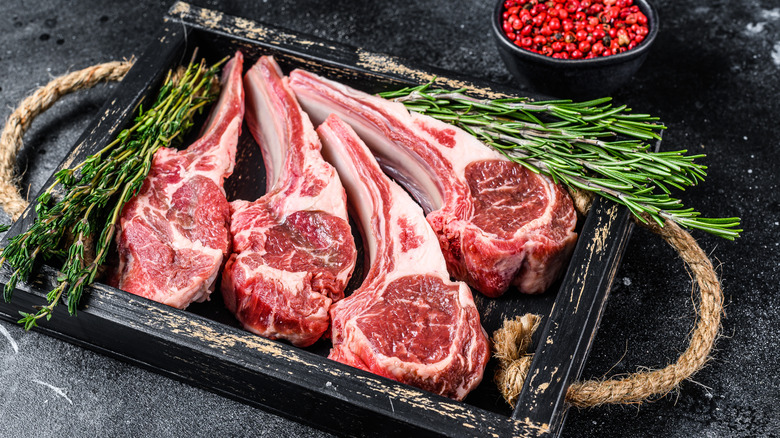Here's How Long Leftover Meats Really Last In The Fridge
We have all played "food safety" roulette a time or two: You give a sniff. Maybe it doesn't smell as enticing as it did on the day you cooked it. But is it bad? It's easy to tell when those last two slices of bread have gone to seed or smell the funk of an expensive soft cheese you forgot to serve when the final episodes of "Bake Off" got too intense. However, long before the green fuzz begins to sprout, bacteria are setting up shop on your foods.
There are actually two different kinds of bacteria according to the USDA: Spoilage bacteria are responsible for degrading the appearance and quality of food products, while pathogenic bacteria turn food toxic and give rise to food-borne illnesses. According to WebMD, multiple different bacteria can grow and proliferate on already cooked meats, including staphylococcus aureus and clostridium perfringens, both of which cause diarrhea, vomiting, and gastrointestinal pains, and are basically undetectable until you're feeling the effects.
Pathogenic bacteria flourish in what food professionals call the "danger zone," or between 41 and 135 degrees, says WedMD. That's why it is so important to properly chill and store leftovers. Let's explore how long various meats can be kept.
Beef steaks
Maybe you filled up on sides, or your eyes were simply larger than your stomach, but you couldn't finish that last half of your steak, so you put it in your fridge for later. Good plan! Just make sure you eat it or toss it within three to four days, warns Still Tasty, an online guide to food safety. Fortunately, steak is versatile and leftovers can be sliced up and used on salads for an easy lunch or added to a ramen bowl for a weekday dinner.
The most important thing to keep in mind when you are storing any leftovers is to make sure that they are tightly wrapped, either with plastic wrap or put into an airtight container. Oxygen can encourage the growth of dangerous toxic bacteria, so the less exposed to the air your meat is, the safer it is to keep. Air-exposure also decreases the quality of the meat by robbing it of moisture. There's nothing more disappointing than going to reheat a once juicy steak and finding it dried out and tough because it wasn't properly wrapped. Protecting your steaks means you can focus on best ways to eat leftover steak for breakfast, instead.
Ground beef
Ground meat has gotten a bad rap when it comes to food safety. In 1993, an e. coli outbreak in Seattle-area Jack in the Box restaurants led to hundreds of illnesses and four deaths (via Food Safety News). The publicity surrounding the outbreak and the fact that most of the victims of the illness were young children had massive repercussions to how meat inspections and general food safety was handled by the U.S. government, according to Food Safety News.
The good news is that increased safety oversight in meat distribution means that most instances of contaminated food are caught before they can impact the general public, making ground beef just as safe as any other meat. The USDA states that, once ground beef is cooked, it can be refrigerated for three to four days before it must be used. You can prolong the lifespan of cooked ground beef by freezing it (up to four months).
Have you ever pulled out raw hamburger and noticed that the middle of it has been grey? Your first impulse might be to write off the batch as spoiled, but the truth is that grey color comes from the fact the meat in the middle of the pack hasn't been exposed to oxygen, which gives it the familiar pinkish red hue that we associate with fresh meat, according to HealthLine. As long as there are no other warning signs such as foul odors or mold, the meat is safe to use.
Ground Poultry
Much like ground beef, ground poultry suffers from the stigma of being especially vulnerable to food borne illness, particularly salmonella. Fortunately, salmonella is destroyed during the cooking process as long as the meat is cooked to the appropriate temperature. Once the meat is cooked, it can last up to three days in the fridge before it needs to be disposed of (via Prepared Cooks).
Just like with ground beef, you want to set yourself up for leftover success by starting the cooking process with fresh, raw meat. Be sure to check for any warning signs that your ground turkey or chicken has spoiled before you start cooking with it. Leftovers are only as good as their original ingredients, so it's smart to heed the advice of HealthLine, if your raw ground turkey has an unpleasant odor or a slimy texture, you'll want to chuck it rather than take the risk. According to Eat Right, while cooking can kill bacteria such as salmonella, heat does not all destroy pathogenic bacteria or toxins. So, no matter if the ground turkey or chicken is cooked all the way through, it still runs the risk of making you sick.
Roasted chicken
What is more comforting or classic than a traditional roast chicken dinner? The snappy skin, the savory drumsticks, the juicy breast meat, there's something innately soul-soothing about this meal. In culinary circles, the true mettle of a chef is measured by how well they can produce this seemingly simple dish (in order to perfect it in your own kitchen, such as in Julia Child's roast chicken recipe. Cooking a whole chicken also gives you a leg-up on meal prep for the rest of the week, so it is extra important that you store the leftovers properly. You don't want your week's worth of meal planning to go south due to bad leftovers!
Once the chicken has been roasted, you want to make sure to break the bird down into smaller components. Thighs, drumsticks, breasts, wings should all be separated from the larger body of the chicken so that the meat can cool evenly. The USDA recommends keeping cooked chicken no longer than three to four days.
If you wanted to stretch that time out, you'll want to wrap the meat up tightly and freeze it. Once frozen, the USDA says the chicken's shelf life goes up to four months. So if you ever get the urge to stock up the freezer, you can get a serious head start on your food prep by roasting and breaking down a couple of chickens on a slow Sunday afternoon!
Thanksgiving turkey
During the most sacred of leftover holidays, Thanksgiving. Arguably, Thanksgiving leftovers are more fun and enjoyable than the original meal. Who doesn't look forward to the days of turkey and stuffing sandwiches? Use up those extra mashed potatoes in a Thanksgiving shepherd's pie recipe. Though it may be super tempting to want to keep those leftovers in your fridge forever and stretch out the holiday until Christmas starts, the actual safe shelf-life is only three to four days, per FoodSafety.gov. That means you can safely indulge in all that turkey and fixin's until the Monday after Thanksgiving.
Make sure you don't let the turkey sit out at room temperature for longer than two hours before getting it into the fridge, says Still Tasty. Just like the roast chicken, the best practice is to break the body of the turkey down into smaller, more manageable pieces and get it out of that temperature danger zone. If you know you aren't going to be able to eat all the remaining turkey meat by Monday, you can freeze it! That way you can enjoy leftovers well into the New Year (per USDA).
Chili
Beans or no beans? Ground beef or steak? These are all important questions when you're making chili. Everyone has their preferences, their family recipes, their secret ingredients. Chili is one of those amorphous dishes that is endlessly customizable. Whether you're an experienced chili chef or a newbie when it comes to this hearty stew. Either way, you can always experiment with some of the best chili recipes in the chilly seasons (see what we did there?). A piping hot bowl will chase away the winter cold.
No matter what your recipe, chili is one of those meals that seems to get better as the days pass. The flavors deepen, the liquid thickens, and it becomes an indulgent addition to omelets, nachos, and hot dogs. According to Still Tasty, you have up to days to smother everything in sight with that chili-goodness before you have to bid adios. Of course, Still Tasty says it can be frozen for up to six months or longer, though flavor quality might start to decrease after the six-month mark, it is still safe to eat.
Bacon and sausage
What is more luxurious than the smell of frying bacon and sausage in the morning? Salty, savory, so decadently greasy, these breakfast champions just can't be beat. The majority of breakfast sausages and bacon that you find on the market are smoked pork. According to Britannica, smoking is believed to be one of the oldest methods of preserving meat. The smoke pulls the moisture from the meat, while chemicals that naturally occur in the burning wood act as preservatives.
Smoked meats have a longer shelf life than unsmoked. They can last up to seven days in the fridge and up to two months in the freezer, according to the University of Minnesota Extension. However, not all bacon and sausages are smoked. Always be sure to read the labels when you purchase your breakfast meats. If you find that your favorite brand isn't smoked (it might also be labeled as "uncured"), then your window of time shortens.
The USDA says raw, unsmoked sausage and bacon lasts two days in the fridge, but, once cooked, that time goes up to four days. Just make sure you're aware of what sort of product you're dealing with when you're choosing a companion for your sunny side up eggs.
Deli meats
Much like bacon and sausage, deli meats often include preservatives to lengthen their shelf life. Sodium nitrite, a curing salt, is most commonly used to keep deli meats safe for consumption. It is an anti-oxidant which inhibits the growth of botulism, one of the most dangerous food borne bacteria (via MeatSafety.org). It also imbues deli meats with that familiar pinkish hue. Per WebMD, Sodium nitrite is actually the defining ingredient in cured meats such as ham and pastrami; those deli favorites wouldn't taste the same without it.
The public demand for more natural food options, however, has led some brands to advertise that their meats are "uncured" or contain no added nitrites. According to the Spruce Eats, typically, you will see that these foods often have ingredients like celery juice, which has a high concentration of sodium nitrate and reacts with certain bacteria or enzymes found in the meats, creating naturally occurring sodium nitrite. Celery juice sounds like much more natural a preservative while, in practice, it is still producing the same chemical used in conventional cold cuts.
Whether you choose the organic route or not, you'll be looking at similar time frames for using up your deli meats. The USDA says that unopened, vacuum-sealed packages can last up to two weeks, and the clock starts ticking down to five days once the seal is cracked.
Canned meat
Many families grew up on a steady diet of canned foods kept on hand in the pantry. Though canned meats might not play into our meals nearly as much as they did in past eras, shuffle through your pantry and you more than likely have a can or two of tinned meats.
The canning process itself makes for some of the safest and longest storing foods on the market today. The contents are super-heated to kill off any bacteria, then the can is hermetically sealed, meaning no air can enter or exit the now sterile can (via Science Direct). As long as the can remains sealed, the USDA finds they'll wait patiently on your shelves for up to five years. Once opened, tuna, chicken, and seafood is good for five to seven days in the fridge, while SPAM and corned beef hash can be refrigerated for seven to ten days, thanks in no small part to added sodium nitrite (per EatByDate).
Always check the integrity of your canned goods. Dented, rusty, and bulging can should be treated with suspicion and discarded. Do not store leftovers in the tin cans they came from as that leaves them vulnerable to pathogenic bacterial growth. Instead, make sure all leftovers are sealed into airtight containers before popping them in the fridge.
Seafood
It was Benjamin Franklin who famously said that "guests, like fish, begin to smell after three days." Much like you never want to overstay your welcome as a houseguest, fresh, raw seafood should not be in your fridge for more than two days before cooking (per USDA). If you foresee a more long-term relationship with your fish or crustaceans, the agency recommends moving them to the freezer for up eight months for fish and 12 months for shellfish.
When it comes to fish, your nose knows, according to L'Academie, which explains any whiff of ammonia when you pull out your seafood means that it has gone bad and needs to be disposed of. Similarly, if the fish has a slimy texture or opaque appearance, it's time for that houseguest to see themselves out to the dumpster.
The good news is that once cooked, seafood's shelf life goes up to three or four days. So, go ahead and enjoy Sunday's paella for Tuesday's lunch. And smoked seafood, like salmon and herring, can last up to seven days in the fridge thanks to the preservative properties of the smoking process (via StillTasty).
Lamb
The holiday season brings lamb to the table. Savory, herby lamb chops, elegant crown roasts, and beautiful lollipops have all been a long-time staple of many cultures' diets. Despite its popularity, lamb remains an under-utilized protein for day-to-day cooking in the U.S. If your intimidated when it comes to lamb, just know that lamb's unique flavor makes this meat shine in every dish and gives it a lot of versatility to be used as leftovers.
Raw, ground lamb can be in the fridge for up to two days before it needs to be cooked, while roasts, ribs, and chops can remain in the fridge between three to five days before cooking (via USDA). Once heat meets meat, you get the standard three to four days to use up the leftovers (per FoodSafety). Don't let any part of the lamb go to waste! You can bring that stand-out flavor to many meals to come by making bone broth from the chop and rib bones. That broth can then be frozen and added to sauces, soups, and other dishes to add that important pop of flavor.
Ham
Turkey may dominate Thanksgiving, but Christmas and Easter have succulent, sweet, and salty ham. Clove-studded or pineapple-glazed, thick steaks or spiral cut on the bone, something about ham evokes the spirit of the holidays. The ham that most of us are familiar with tends to be both brined and smoked, which means that it already has a leg-up on most other leftovers as far as shelf-life goes.
The sheer size of a typical spiral cut ham means plenty of leftovers. So, how long can you keep leftover ham in the fridge? The USDA states that, once cooked, ham can be refrigerated for three to five days or frozen for up to two months. That means you have a good few days to make melty cubanos, brunchy quiches, or comforting split-pea soup. You do also want to consider how to safely bring the meat back up to temp while preserving the quality.
